Mongolia
Mongolia | |
|---|---|
| Anthem: Монгол улсын төрийн дуулал Mongol ulsyn töriin duulal " semi-presidential republic[3] | |
| Ukhnaagiin Khürelsükh | |
| Luvsannamsrain Oyun-Erdene | |
| Gombojavyn Zandanshatar | |
| Legislature | State Great Khural |
| Formation | |
| 209 BC | |
| 1206 | |
• Completion of Qing dynasty conquest | 1691 |
• Declaration of independence from the Qing dynasty | 29 December 1911 |
• Mongolian People's Republic established | 26 November 1924 |
| 12 February 1992 | |
+976 | |
| ISO 3166 code | MN |
| Internet TLD | .mn, .мон |
Mongolia[b] is a landlocked country in East Asia, bordered by Russia to the north and China to the south. It covers an area of 1,564,116 square kilometres (603,909 square miles), with a population of just 3.3 million, making it the world's most sparsely populated sovereign state. Mongolia is the world's largest landlocked country that does not border a closed sea, and much of its area is covered by grassy steppe, with mountains to the north and west and the Gobi Desert to the south. Ulaanbaatar, the capital and largest city, is home to roughly half of the country's population.
The territory of modern-day Mongolia has been ruled by various
Approximately 30% of the population is nomadic or semi-nomadic; horse culture remains integral. Buddhism is the majority religion (51.7%), with the nonreligious being the second-largest group (40.6%). Islam is the third-largest religious identification (3.2%), concentrated among ethnic Kazakhs. The vast majority of citizens are ethnic Mongols, with roughly 5% of the population being Kazakhs, Tuvans, and other ethnic minorities, who are especially concentrated in the western regions. Mongolia is a member of the United Nations, Asia Cooperation Dialogue, G77, Asian Infrastructure Investment Bank, Non-Aligned Movement and a NATO global partner. Mongolia joined the World Trade Organization in 1997 and seeks to expand its participation in regional economic and trade groups.[4]
Etymology
| Mongolia | |||||
|---|---|---|---|---|---|
| Mongolian name | |||||
Mongolian Cyrillic | Монгол Улс (Mongol Uls) | ||||
| Mongolian script | ᠮᠣᠩᠭᠣᠯ ᠤᠯᠤᠰ | ||||
| |||||
The name Mongolia means the "Land of the Mongols" in Latin. The Mongolian word "Mongol" (
After the fall of the Liao in 1125, the Khamag Mongols became a leading tribe on the Mongolian Plateau. However, their wars with the Jurchen-ruled Jin dynasty and the Tatar confederation had weakened them. The last head of the tribe was Yesügei, whose son Temüjin eventually united all the Shiwei tribes as the Mongol Empire (Yekhe Monggol Ulus). In the thirteenth century, the word Mongol grew into an umbrella term for a large group of Mongolic-speaking tribes united under the rule of Genghis Khan.[18]
Since the adoption of the new Constitution of Mongolia on 13 February 1992, the official name of the state is "Mongolia" (Mongol Uls).
History
Prehistory and antiquity
The
Although cultivation of crops has continued since the Neolithic, agriculture has always remained small in scale compared to pastoral nomadism. Agriculture may have first been introduced from the west or arose independently in the region. The population during the
Early states

Since prehistoric times, Mongolia has been inhabited by nomads who, from time to time, formed great confederations that rose to power and prominence. Common institutions were the office of the
The Göktürks laid siege to
Lines 3–5 of the memorial inscription of
In battles they subdued the nations of all four sides of the world and suppressed them. They made those who had heads bow their heads, and who had knees genuflect them. In the east up to the Kadyrkhan common people, in the west up to the Iron Gate they conquered... These Khagans were wise. These Khagans were great. Their servants were wise and great too. Officials were honest and direct with people. They ruled the nation this way. This way they held sway over them. When they died ambassadors from Bokuli Cholug (Baekje Korea), Tabgach (Tang China), Tibet (Tibetan Empire),
Mongol empire to early 20th century
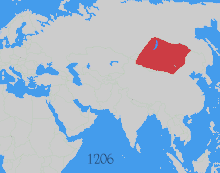


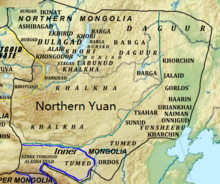
In the chaos of the late 12th century, a chieftain named Temüjin finally succeeded in uniting the Mongol tribes between Manchuria and the Altai Mountains. In 1206, he took the title Genghis Khan, and waged a series of military campaigns – renowned for their brutality and ferocity – sweeping through much of Asia, and forming the Mongol Empire, the largest contiguous land empire in world history. Under his successors it stretched from present-day Poland in the west to Korea in the east, and from parts of Siberia in the north to the Gulf of Oman and Vietnam in the south, covering some 33,000,000 square kilometres (13,000,000 sq mi),[24] (22% of Earth's total land area) and had a population of over 100 million people (about a quarter of Earth's total population at the time). The emergence of Pax Mongolica also significantly eased trade and commerce across Asia during its height.[25][26]
After Genghis Khan's death, the empire was subdivided into four kingdoms or Khanates. These eventually became quasi-independent after the Toluid Civil War (1260–1264), which broke out in a battle for power following Möngke Khan's death in 1259. One of the khanates, the "Great Khaanate", consisting of the Mongol homeland and most of modern-day China, became known as the Yuan dynasty under Kublai Khan, the grandson of Genghis Khan. He set up his capital in present-day Beijing. After more than a century of power, the Yuan dynasty was overthrown by the Ming dynasty in 1368, and the Yuan court fled to the north, thus becoming the Northern Yuan dynasty. As the Ming armies pursued the Mongols into their homeland, they successfully sacked and destroyed the Mongol capital Karakorum and other cities. Some of these attacks were repelled by the Mongols under Ayushridar and his general Köke Temür.[27]
After the expulsion of the Yuan rulers from China proper, the Mongols continued to rule their homeland, known in historiography as the Northern Yuan dynasty. With the division of the Mongol tribes, it was subsequently also known as "The Forty and the Four" (Döčin dörben) among them.[28] The next centuries were marked by violent power struggles among various factions, notably the Genghisids and the non-Genghisid Oirats, as well as by several Ming invasions (such as the five expeditions led by the Yongle Emperor).
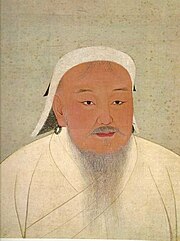
In the early 16th century, Dayan Khan and his khatun Mandukhai reunited all Mongol groups under the Genghisids. In the mid-16th century, Altan Khan of the Tümed, a grandson of Dayan Khan – but not a hereditary or legitimate Khan – became powerful. He founded Hohhot in 1557. After he met with the Dalai Lama in 1578, he ordered the introduction of Tibetan Buddhism to Mongolia. (It was the second time this had occurred.) Abtai Khan of the Khalkha converted to Buddhism and founded the Erdene Zuu monastery in 1585. His grandson Zanabazar became the first Jebtsundamba Khutughtu in 1640. Following the leaders, the entire Mongolian population embraced Buddhism. Each family kept scriptures and Buddha statues on an altar at the north side of their yurt. Mongolian nobles donated land, money and herders to the monasteries. As was typical in states with established religions, the top religious institutions, the monasteries, wielded significant temporal power in addition to spiritual power.[29]
The last Khagan of Mongols was
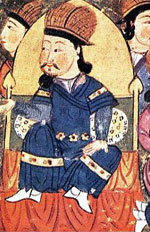
Some scholars estimate that about 80% of the 600,000 or more Dzungar were killed by a combination of disease and warfare.[31] Outer Mongolia was given relative autonomy, being administered by the hereditary Genghisid khanates of Tusheet Khan, Setsen Khan, Zasagt Khan and Sain Noyon Khan. The Jebtsundamba Khutuktu of Mongolia had immense de facto authority. The Manchu forbade mass Chinese immigration into the area, which allowed the Mongols to keep their culture. The Oirats who migrated to the Volga steppes in Russia became known as Kalmyks.
The main trade route during this period was the Tea Road through Siberia; it had permanent stations located every 25 to 30 kilometres (16 to 19 mi), each of which was staffed by 5–30 chosen families.
Until 1911, the Qing dynasty maintained control of Mongolia with a series of alliances and intermarriages, as well as military and economic measures. Ambans, Manchu "high officials", were installed in Khüree, Uliastai, and Khovd, and the country was divided into numerous feudal and ecclesiastical fiefdoms (which also placed people in power with loyalty to the Qing). Over the course of the 19th century, the feudal lords attached more importance to representation and less importance to the responsibilities towards their subjects. The behavior of Mongolia's nobility, together with usurious practices by Chinese traders and the collection of imperial taxes in silver instead of animals, resulted in widespread poverty among the nomads. By 1911 there were 700 large and small monasteries in Outer Mongolia; their 115,000 monks made up 21% of the population. Apart from the Jebtsundamba Khutuktu, there were 13 other reincarnating high lamas, called 'seal-holding saints' (tamgatai khutuktu), in Outer Mongolia.
Modern history

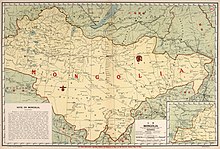
With the fall of the Qing dynasty in 1911, Mongolia under the
The area controlled by the Bogd Khaan was approximately that of the former
To eliminate the threat posed by Ungern,
Mongolian People's Republic
In 1924, after the

Khorloogiin Choibalsan instituted collectivization of livestock, began the destruction of the Buddhist monasteries, and carried out Stalinist purges, which resulted in the murders of numerous monks and other leaders. In Mongolia during the 1920s, approximately one-third of the male population were monks. By the beginning of the 20th century, about 750 monasteries were functioning in Mongolia.[36]
In 1930, the Soviet Union stopped

After the Japanese invasion of neighboring Manchuria in 1931, Mongolia was threatened on this front. During the Soviet-Japanese Border War of 1939, the Soviet Union successfully defended Mongolia against Japanese expansionism. Mongolia fought against Japan during the Battles of Khalkhin Gol in 1939 and during the Soviet–Japanese War in August 1945 to liberate Inner Mongolia from Japan and Mengjiang.[39]
Cold War
The February 1945 Yalta Conference provided for the Soviet Union's participation in the Pacific War. One of the Soviet conditions for its participation, put forward at Yalta, was that after the war Outer Mongolia would retain its independence. The referendum took place on 20 October 1945, with (according to official numbers) 100% of the electorate voting for independence.[40]
After the establishment of the

On 26 January 1952, Yumjaagiin Tsedenbal took power in Mongolia after the death of Choibalsan. Tsedenbal was the leading political figure in Mongolia for more than 30 years.[44] While Tsedenbal was visiting Moscow in August 1984, his severe illness prompted the parliament to announce his retirement and replace him with Jambyn Batmönkh.
Post-Cold War
The
A new constitution was introduced in 1992, and the term "People's Republic" was dropped from the country's name. The transition to a market economy was often rocky; during the early 1990s the country had to deal with high inflation and food shortages.[45] The first election victories for non-communist parties came in 1993 (presidential elections) and 1996 (parliamentary elections). China has supported Mongolia's application for membership in the Asia Cooperation Dialogue (ACD), Asia-Pacific Economic Cooperation (APEC) and granting it observer status in the Shanghai Cooperation Organisation.[46]
Geography and climate
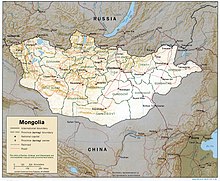
At 1,564,116 km2 (603,909 sq mi), Mongolia is the world's
The geography of Mongolia is varied, with the
The western extremity of Mongolia is only 37 km (23 mi) from Kazakhstan, and this area can resemble a quadripoint when viewed on a map.
Climate
Mongolia is known as the "Land of the Eternal Blue Sky" or "Country of Blue Sky" (Mongolian: "Mönkh khökh tengeriin oron") because it has over 250 sunny days a year.[50][51][52][53]
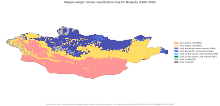
Most of the country is hot in the summer and extremely cold in the winter, with January averages dropping as low as −30 °C (−22 °F).
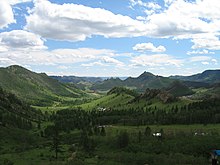
In winter the whole of Mongolia comes under the influence of the
The country is subject to occasional harsh climatic conditions known as zud. It results in large proportions of the country's livestock dying from starvation or freezing temperatures or both, resulting in economic upheaval for the largely pastoral population. The annual average temperature in Ulaanbaatar is −1.3 °C (29.7 °F), making it the world's coldest capital city.[54] Mongolia is high, cold and windy.[57] It has an extreme continental climate with long, cold winters and short summers, during which most of its annual precipitation falls.[57] The country averages 257 cloudless days a year, and it is usually at the center of a region of high atmospheric pressure.[57] Precipitation is highest in the north (average of 200 to 350 millimeters (8 to 14 in) per year) and lowest in the south, which receives 100 to 200 millimeters (4 to 8 in) annually.[57] The highest annual precipitation of 622.297 mm (24.500 in) occurred in the forests of Bulgan Province near the border with Russia and the lowest of 41.735 mm (1.643 in) occurred in the Gobi Desert (period 1961–1990).[58] The sparsely populated far north of Bulgan Province averages 600 mm (24 in) in annual precipitation which means it receives more precipitation than Beijing (571.8 mm or 22.51 in) or Berlin (571 mm or 22.5 in).
Environmental issues

Wildlife
The name "Gobi" is a Mongol term for a desert steppe, which usually refers to a category of arid rangeland with insufficient vegetation to support marmots but with enough to support camels.[57] Mongols distinguish Gobi from desert proper, although the distinction is not always apparent to outsiders unfamiliar with the Mongolian landscape.[57]
Gobi rangelands are fragile and easily destroyed by overgrazing, which results in expansion of the true desert, a stony waste where not even
Mongolia had a 2019 Forest Landscape Integrity Index mean score of 9.36/10, ranking it sixth globally out of 172 countries.[60]
Demographics

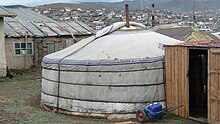
Mongolia's total population as of January 2015 was estimated by the
The first census in the 20th century was carried out in 1918 and recorded a population of 647,500.[64] Since the end of socialism, Mongolia has experienced a decline of total fertility rate (children per woman) that is steeper than in any other country in the world, according to recent UN estimations:[63] in 1970–1975, fertility was estimated to be 7.33 children per woman, dropping to about 2.1 in 2000–2005.[65] The decline ended and in 2005–2010, the fertility value increased to 2.8 in 2013 and stabilised afterwards at a rate of about 2.5-2.6 children per woman around 2020.[66]
The Mongols are moderately homogeneous,
Languages
The official language of Mongolia is Mongolian, and is spoken by 95% of the population. A variety of dialects of Oirat and Buryat are spoken across the country, and there are also some speakers of Mongolic Khamnigan. In the west of the country, Kazakh and Tuvan, both Turkic languages, are also spoken. Mongolian Sign Language is the principal language of the deaf community.
Today, Mongolian is written using the
Russian is the most frequently spoken foreign language in Mongolia, followed by English, although English has been gradually replacing Russian as the second language. Korean has gained popularity as tens of thousands of Mongolians work in South Korea.[73]
Religion
| Religion | Population | Share |
|---|---|---|
| Non-religious | 735,283 | 38.6% |
| Religious | 1,170,283 | 61.4% |
| Buddhism | 1,009,357 | 53.0% |
| Islam | 57,702 | 3.0% |
| Shamanism | 55,174 | 2.9% |
| Christianity | 41,117 | 2.2% |
| Other religions | 6,933 | 0.4% |
| Total | 1,905,566 | 100.0% |
According to the 2010 National Census, among Mongolians aged 15 and above, 53% were Buddhists, while 39% were non-religious.
Mongolian shamanism has been widely practised throughout the history of what is now Mongolia, with similar beliefs being common among the nomads of central Asia. They gradually gave way to Tibetan Buddhism, but shamanism has left a mark on Mongolian religious culture, and it continues to be practiced. The Kazakhs of western Mongolia, some Mongols, and other Turkic peoples in the country traditionally adhere to Islam.
Throughout much of the 20th century, the

The
The end of religious repression in the 1990s also allowed for other religions to spread in the country. According to the Christian missionary group
Government and politics

Mongolia is a
Mongolia has a number of political parties; the largest are the Mongolian People's Party and the Democratic Party. The non-governmental organization Freedom House considers Mongolia to be free.[86]
The People's Party – known as the People's Revolutionary Party between 1924 and 2010 – formed the government from 1921 to 1996 (in a one-party system until 1990) and from 2000 to 2004. From 2004 to 2006, it was part of a coalition with the Democrats and two other parties, and after 2006 it was the dominant party in two other coalitions. The party initiated two changes of government from 2004 prior to losing power in the 2012 election. The Democrats were the dominant force in a ruling coalition between 1996 and 2000, and an almost-equal partner with the People's Revolutionary Party in a coalition between 2004 and 2006. An election of deputies to the national assembly on 28 June 2012 resulted in no party having an overall majority;
The
In June 2021, former Prime Minister Ukhnaa Khurelsukh, the candidate of the ruling Mongolian People's Party (MPP), became the country's sixth democratically elected president after winning the presidential election.[98]
Mongolia uses a unicameral legislature, the State Great Khural, with 76 seats, which is chaired by the Speaker of the House. Its members are directly elected, every four years, by popular vote.[3]
Foreign relations
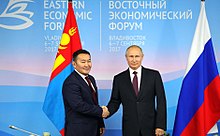
Mongolia's foreign relations traditionally focus on its two large neighbors, Russia and China.[99] Mongolia is economically dependent on these countries: China receives 90% of Mongolia's exports by value and accounts for 60% of its foreign trade, while Russia supplies 90% of Mongolia's energy requirements.[4] Mongolia also pursues trilateral partnership with China and Russia through the Power of Siberia 2 natural gas pipeline, construction of which is expected to begin in 2024.[100] Mongolia's most important trading partner is China, and the government has been trying to stay out of the current US-China confrontation.[101]
It has begun seeking positive relations with a wider range of other countries especially in cultural and economic matters, focusing on encouraging foreign direct investment and trade.[102] Mongolia has been pursuing a 'third-neighbor' foreign policy since early 1990s to build deeper relations and partnerships with countries beyond its two surrounding neighbors.[103]
Mongolia has been a member of
Then Vice President of the US, Joe Biden, visited Mongolia in 2011 supporting Mongolia's third neighbor policy.[105]
Embassies
Mongolia maintains many
Military

Mongolia supported the
From 2005 to 2006, about 40 troops were deployed with the Belgian and Luxembourg contingents in Kosovo. On 21 November 2005, George W. Bush became the first-ever sitting U.S. president to visit Mongolia.[108] In 2004, under Bulgarian chairmanship, the Organization for Security and Co-operation in Europe (OSCE) invited Mongolia as its newest Asian partner.
Legal system
The judiciary of Mongolia is made of a three-tiered court system:
A Judicial General Council (JGC) nominates judges which must then be confirmed by the parliament and appointed by the President.
Arbitration centres provide alternative dispute resolution options for commercial and other disputes.[110]
Administrative divisions
Mongolia is divided into 21 provinces (aimags) and subdivided into 331 districts (sums).[111] Ulaanbaatar is administered separately as a capital city (municipality) with provincial status. The aimags are:
Major cities
This section needs to be updated. (February 2019) |
The percentage of the population the top 10 most populous cities make up.
About 40% of the population lives in Ulaanbaatar, and in 2002 a further 23% lived in
Largest cities or towns in Mongolia
2020 | |||||||||
|---|---|---|---|---|---|---|---|---|---|
| Rank | Name | Province | Pop. | Rank | Name | Province | Pop. | ||
Ulaanbaatar  Erdenet |
1 | Ulaanbaatar | Ulaanbaatar | 1,426,645 | 11 | Ulaangom | Uvs | 30,958 | |
| 2 | Erdenet | Orkhon | 101,421 | 12 | Baganuur* | Ulaanbaatar | 29,342 | ||
| 3 | Darkhan | Darkhan-Uul | 83,213 | 13 | Dalanzadgad | Ömnögovi | 27,525 | ||
| 4 | Choibalsan | Dornod | 46,683 | 14 | Sainshand | Dornogovi | 26,558 | ||
| 5 | Mörön | Khövsgöl | 41,586 | 15 | Chinggis City | Khentii | 24,036 | ||
| 6 | Nalaikh* | Ulaanbaatar | 38,960 | 16 | Sükhbaatar | Selenge | 22,470 | ||
| 7 | Ölgii | Bayan-Ölgii | 38,310 | 17 | Tsetserleg | Arkhangai | 20,645 | ||
| 8 | Arvaikheer | Övörkhangai | 33,743 | 18 | Züünkharaa | Selenge | 19,934 | ||
| 9 | Bayankhongor | Bayankhongor | 31,948 | 19 | Baruun-Urt | Sükhbaatar | 19,255 | ||
| 10 | Khovd | Khovd | 31,081 | 20 | Zamyn-Üüd | Dornogovi | 19,116 | ||
Economy
This section needs to be updated. (August 2016) |


Economic activity in Mongolia has long been based on herding and agriculture, although development of extensive mineral deposits of copper, coal, molybdenum, tin, tungsten and gold have emerged as a driver of industrial production.[113] Besides mining (21.8% of GDP) and agriculture (16% of GDP), dominant industries in the composition of GDP are wholesale and retail trade and service, transportation and storage, and real estate activities.[113] Also, Mongolia produces one-fifth of the world's raw cashmere.[114]
The
Mongolia is ranked as a lower-middle-income economy by the World Bank.[116] Some 22.4% of the population lives on less than US$1.25 a day.[117] In 2011, GDP per capita was $3,100.[4] Despite growth, the proportion of the population below the poverty line was estimated to be 35.6% in 1998, 36.1% in 2002–2003, and 32.2% in 2006.[118]
Because of a boom in the mining sector, Mongolia had high growth rates[
Mongolia was never listed among the
Mineral industry
Minerals represent more than 80% of Mongolia's exports, a proportion expected to eventually rise to 95%. Fiscal revenues from mining represented 21% of government income in 2010 and rose to 24% in 2018.[126][127] About 3,000 mining licences have been issued.[119] Mining continues to rise as a major industry of Mongolia as evidenced by the number of Chinese, Russian and Canadian firms starting mining businesses in Mongolia.[4]
In 2009, the government negotiated an "investment agreement" with
In September 2022, Mongolia built and launched a 233-km direct rail link to China, which is a milestone in Mongolia's plan to become China's leading supplier of high-quality coal from the Tavan Tolgoi mine, which has more than six billion tonnes of coal reserves.[129]
Agriculture
This article needs to be updated. (April 2010) |
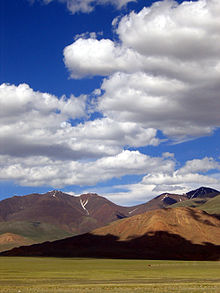
Agriculture in Mongolia constitutes over 10% of Mongolia's annual gross domestic product and employs one-third of the labor force.[130] However, the high altitude, extreme fluctuation in temperature, long winters, and low precipitation provides limited potential for agricultural development. The growing season is only 95 – 110 days.[131] Because of Mongolia's harsh climate, it is unsuited to most cultivation.
The agriculture sector therefore remains heavily focused on nomadic animal husbandry with 75% of the land allocated to pasture, and cropping only employing 3% of the population. In 2002, about 30% of all households in Mongolia lived from breeding livestock.
Infrastructure
Communications
Telecommunications in Mongolia face unique challenges. As the least densely populated country in the world, with a significant portion of the population living a nomadic lifestyle, it has been difficult for many traditional
Postal services are provided by state-owned Mongol Post and 54 other licensed operators.[135]
Energy
Mongolia imports 98% of its fuel and is building its first ever oil refinery to reduce its foreign energy dependency.[138]
Transportation


The Trans-Mongolian Railway is the main rail link between Mongolia and its neighbors. It begins at the Trans-Siberian Railway in Russia at the town of Ulan-Ude, crosses into Mongolia, runs through Ulaanbaatar, then passes into China at Erenhot where it joins the Chinese railway system. A separate railroad link connects the eastern city of Choibalsan with the Trans-Siberian Railway. However, that link is closed to passengers after the Mongolian town of Chuluunkhoroot.[139] Mongolia also has a 233 km-long cargo rail link from the Tavan Tolgoi coal mine to Chinese border.[140]
Mongolia has a number of domestic airports, with some of them having international status. However, the main international airport is Chinggis Khaan International Airport, located approximately 52 km (32 mi) south of the capital Ulaanbaatar. Direct flight connections exist between Mongolia and South Korea, China, Thailand, Hong Kong, Japan, Russia, Germany, and Turkey. MIAT Mongolian Airlines is Mongolia's national air carrier, operating international flights, while air carriers such as Aero Mongolia and Hunnu Airlines serve domestic and short international routes.
Many overland roads in Mongolia are only gravel roads or simple cross-country tracks. There are paved roads from Ulaanbaatar to the Russian and Chinese borders, from Ulaanbaatar east- and westward (the so-called Millennium Road), and from Darkhan to Bulgan. A number of road construction projects are currently underway. Mongolia has 4,800 km (3,000 mi) of paved roads, with 1,800 km (1,100 mi) of that total completed in 2013 alone.[141]
Education
During the state socialist period, education was one of the areas of significant achievement in Mongolia. Before the People's Republic, literacy rates were below one percent. By 1952, illiteracy was virtually eliminated,[142] in part through the use of seasonal boarding schools for children of nomadic families. Funding to these boarding schools was cut in the 1990s, contributing to slightly increased illiteracy.
Primary and secondary education formerly lasted ten years, but was expanded to eleven years. Since the 2008–2009 school year, new first-graders are using the 12-year system, with a full transition to the 12-year system in the 2019–2020 school year.[143]
As of 2006[update], English is taught in all secondary schools across Mongolia, beginning in fourth grade. English has taken over from Russian as the dominant foreign language in Mongolia, particularly in Ulaanbaatar.[144]
Mongolian national universities are all spin-offs from the National University of Mongolia and the Mongolian University of Science and Technology. Almost three in five Mongolian youths now enroll in university. There was a six-fold increase in students between 1993 and 2010.[145] Mongolia was ranked 68th in the Global Innovation Index in 2023, down from 53rd in 2019.[146][147][148]
Health

Modern Mongolia inherited a relatively good healthcare system from its socialist period, a world bank report from 2007 notes "despite its low per capita income, Mongolia has relatively strong health indicators; a reflection of the important health gains achieved during the socialist period." On average Mongolia's infant mortality rate is less than half of that of similarly economically developed countries, its under-five mortality rate and life expectancy are all better on average than other nations with similar GDP per capita.[149]
Since 1990, key health indicators in Mongolia like life expectancy and infant and child mortality have steadily improved, both due to social changes and to improvement in the health sector. Echinococcosis was one of the commonest surgical diagnoses in the 1960s, but now has been greatly reduced.[150] Yet, adult health deteriorated during the 1990s and the first decade of the 21st century and mortality rates increased significantly.[151] Smallpox, typhus, plague, poliomyelitis, and diphtheria were eradicated by 1981. The Mongolian Red Cross Society focuses on preventive work. The Confederation of Mongolian Trade Unions established a network of sanatoriums.[152]
Serious problems remain, especially in the countryside.[153] According to a 2011 study by the World Health Organization, Mongolia's capital city, Ulaanbaatar, has the second highest level of fine particle pollution of any city in the world.[154] Poor air quality is also the largest occupational hazard, as over two-thirds of occupational disease in Mongolia is dust induced chronic bronchitis or pneumoconiosis.[155]
Average childbirth (Culture
The symbol in the left bar of the national flag is a Buddhist icon called Soyombo. It represents the sun, moon, stars, and heavens per standard cosmological symbology abstracted from that seen in traditional thangka paintings.
Visual arts
Before the 20th century, most works of the fine arts in Mongolia had a religious function, and therefore Mongolian fine arts were heavily influenced by religious texts.
In the late 19th century, painters like "Marzan" Sharav turned to more realistic painting styles. Under the Mongolian People's Republic, socialist realism was the dominant painting style,[163] however traditional thangka-like paintings dealing with secular, nationalist themes were also popular, a genre known as "Mongol zurag".
Among the first attempts to introduce modernism into the fine arts of Mongolia was the painting Ehiin setgel (Mother's love) created by Tsevegjav in the 1960s. The artist was purged as his work was censored.[citation needed]
All forms of fine arts flourished only after perestroika in the late 1980s. Otgonbayar Ershuu is arguably one of the most well-known Mongolian modern artists in the Western world, he was portrayed in the film "ZURAG" by Tobias Wulff.[164]
Architecture
The traditional Mongolian dwelling is known as a ger. In the past it was known by the Russian term yurt, but this has been changing as the Mongolian term becomes better known in English-speaking countries. According to Mongolian artist and art critic N. Chultem, the ger was the basis for development of traditional Mongolian architecture. In the 16th and 17th centuries, lamaseries were built throughout the country. Many of them started as ger-temples. When they needed to be enlarged to accommodate the growing number of worshippers, the Mongolian architects used structures with 6 and 12 angles[clarification needed] with pyramidal roofs to approximate to the round shape of a ger. Further enlargement led to a quadratic shape of the temples. The roofs were made in the shape of marquées.[165] The trellis walls, roof poles and layers of felt were replaced by stone, brick, beams and planks, and became permanent.[166]
Chultem distinguished three styles in traditional Mongolian architecture: Mongolian,
Music

The music of Mongolia is strongly influenced by nature, nomadism, shamanism, and also Tibetan Buddhism. The traditional music includes a variety of instruments, famously the morin khuur, and also the singing styles like the urtyn duu ("long song"), and throat-singing (khoomei). The "tsam" is danced to keep away evil spirits and it was seen as reminiscent of shamanism.
Media

Mongolian press began in 1920 with close ties to the Soviet Union under the Mongolian Communist Party, with the establishment of the Unen ("Truth") newspaper similar to the Soviet Pravda.[167] Until reforms in the 1990s, the government had strict control of the media and oversaw all publishing, in which no independent media were allowed.[167] The dissolution of the Soviet Union had a significant impact on Mongolia, where the one-party state grew into a multi-party democracy, and with that, media freedoms came to the forefront.
A new law on press freedom, drafted with help from international NGOs on August 28, 1998 and enacted on January 1, 1999, paved the way for media reforms.[168] The Mongolian media currently consists of around 300 print and broadcasting outlets.[169]
Since 2006, the media environment has been improving with the government debating a new Freedom of Information Act, and the removal of any affiliation of media outlets with the government.[170][171] Market reforms have led to an annually increasing number of people working in the media, along with students at journalism schools.[170]
In its 2013 World Press Freedom Index report, Reporters Without Borders classified the media environment as 98th out of 179, with 1st being most free.[172] In 2016, Mongolia was ranked 60th out of 180.[173]
According to 2014 Asian Development Bank survey, 80% of Mongolians cited television as their main source of information.[174]
Mongolian cuisine

Mongolian cuisine predominantly consists of dairy products, meat, and animal fats. The most common rural dish is cooked mutton. In the city, steamed dumplings filled with meat—"buuz"— are popular.
The extremeSports and festivals

The main national festival is Naadam, which has been organized for centuries and takes place over three days in the summer, consisting of three Mongolian traditional sports, archery, cross-country horse-racing, and wrestling, traditionally recognized as the Three Manly Games of Naadam. In modern-day Mongolia, Naadam is held from July 11 to 13 in the honor of the anniversaries of the National Democratic Revolution and foundation of the Great Mongol State.
Another very popular activity called Shagaa is the "flicking" of sheep ankle bones at a target several feet away, using a flicking motion of the finger to send the small bone flying at targets and trying to knock the target bones off the platform. At Naadam, this contest is popular among older Mongolians.

Horse riding is especially central to Mongolian culture. The long-distance races that are showcased during Naadam festivals are one aspect of this, as is the popularity of trick riding. One example of trick riding is the legend that the Mongolian military hero Damdin Sükhbaatar scattered coins on the ground and then picked them up while riding a horse at full gallop.
Mongolian wrestling is the most popular of all Mongol sports. It is the highlight of the Three Manly Games of Naadam. Historians claim that Mongol-style wrestling originated some seven thousand years ago. Hundreds of wrestlers from different cities and aimags around the country take part in the national wrestling competition.
Other sports such as basketball, weightlifting, powerlifting, association football, athletics, gymnastics, table tennis, jujutsu, karate, aikido, kickboxing, and mixed martial arts have become popular in Mongolia. More Mongolian table tennis players are competing internationally.
Freestyle wrestling has been practised since 1958 in Mongolia.[176] Mongolian freestyle wrestlers have won the first and the most Olympic medals of Mongolia.
Naidangiin Tüvshinbayar won Mongolia's first ever Olympic gold medal in the men's 100-kilogram class of judo.[177]
Amateur boxing has been practised in Mongolia since 1948.[178] The Mongolian Olympic boxing national team was founded in 1960. The Communist government of Mongolia banned boxing from 1964 to 1967 but the government soon ended the ban. Professional boxing began in Mongolia in the 1990s.
Association football is also played in Mongolia. The
Several Mongolian women have excelled in pistol shooting: Otryadyn Gündegmaa is a silver medalist of the 2008 Olympic Games, Munkhbayar Dorjsuren is a double world champion and Olympic bronze medal winner (now representing Germany), while Tsogbadrakhyn Mönkhzul is, as of May 2007, ranked third in the world in the 25-metre pistol event.[179]
Mongolian
Bandy is the only sport in which Mongolia has finished higher than third place at the Asian Winter Games, which happened in 2011 when the national team captured the silver medal. It led to being chosen as the best Mongolian sports team of 2011.[180] Mongolia won the bronze medal of the B division at the 2017 Bandy World Championship after which the then President of Mongolia, Tsakhiagiin Elbegdorj, held a reception for the team.[181]
Ulaanbataar holds an annual marathon in June. 2015 was the sixth marathon that has been organized by Ar Mongol. The race starts at Sukhbataar Square and is always open to residents and runners who come especially for this event.[182]

Mongolia holds other traditional festivals throughout the year. The
See also
Notes
- ^ Also spelled as "Ulan Bator".
- ^ Mongolian: Монгол Улс, romanized: Mongol Uls; Mongolian script: ᠮᠤᠩᠭᠤᠯ ᠤᠯᠤᠰ, Mongolian pronunciation: [mɔŋɢəɮ ʊɮs], moŋɣol ulus; lit. "Mongol Nation" or "State of Mongolia"
/mɒŋˈɡoʊliə/ ⓘ mong-GOH-lee-ə
References
- ^ "Official Documents to be in Mongolian Script". UB Post. 21 June 2011. Archived from the original on 1 November 2011. Retrieved 11 July 2010.
- ^ a b "Хун ам, орон сууцны 2020 оны улсын ээлжит тооллогы нэгдсэн дун" (PDF) (in Mongolian). Archived from the original (PDF) on 7 November 2020. Retrieved 16 August 2021.
- ^ a b c Odonkhuu, Munkhsaikhan (February 12, 2016). "Mongolia: A Vain Constitutional Attempt to Consolidate Parliamentary Democracy". ConstitutionNet. International IDEA. Archived from the original on February 25, 2016. Retrieved February 21, 2016.
Mongolia is sometimes described as a semi-presidential system because, while the prime minister and cabinet are collectively responsible to the SGKh, the president is popularly elected, and his/her powers are much broader than the conventional powers of heads of state in parliamentary systems.
- ^ a b c d e "Mongolia". The World Factbook. CIA. Archived from the original on January 9, 2021. Retrieved August 9, 2015.
- ^ "Mongolia". The World Factbook (2024 ed.). Central Intelligence Agency. Retrieved 24 September 2022. (Archived 2022 edition.)
- ^ a b c d "World Economic Outlook Database, October 2023 Edition. (Mongolia)". International Monetary Fund. 10 October 2023. Retrieved 16 October 2023.
- ^ "GINI index (World Bank estimate) – Mongolia". data.worldbank.org. World Bank. Archived from the original on 1 January 2020. Retrieved 22 March 2020.
- ^ "Human Development Report 2023/24" (PDF). United Nations Development Programme. 13 March 2024. Retrieved 13 March 2024.
- ^ "Mongolia Standard Time is GMT (UTC) +8, some areas of Mongolia use GMT (UTC) +7". Time Temperature.com. Archived from the original on October 13, 2007. Retrieved September 30, 2007.
- ^ Michael Jerryson, Mongolian Buddhism: The Rise and Fall of the Sangha, (Chiang Mai: Silkworm Books, 2007), 89.
- ^ "Mongolia – Religion". Michigan State University. Archived from the original on March 15, 2015. Retrieved January 24, 2015.
- ISBN 9780792308768. Archivedfrom the original on September 4, 2015. Retrieved June 28, 2013.
- ^ National University of Mongolia, School of Social Sciences, Department of History (1999). "2. Хүний үүсэл, Монголчуудын үүсэл гарвал" [2. Origins of Humanity; Origins of the Mongols]. Монгол улсын түүх [History of Mongolia] (in Mongolian). Admon. pp. 67–69.
{{cite book}}: CS1 maint: multiple names: authors list (link) - Rouran) state]. Монголын эртний түүх судлал, III боть [Historiography of Ancient Mongolia, Volume III] (in Mongolian). Vol. 3. pp. 330–550.
- ^ ISBN 978-0199554270.
- ISBN 0-7748-0366-5..
- ^ Baxter, Wm. H. & Sagart, Laurent. "Baxter–Sagart Old Chinese Reconstruction". Archived from the original on 25 April 2012. (1.93 MB). 2011. Retrieved 11 October 2011.
- ^ "Mongolia: Ethnography of Mongolia". Encyclopædia Britannica. Archived from the original on 6 July 2008. Retrieved 22 July 2007.
- ^ a b Eleanora Novgorodova, Archäologische Funde, Ausgrabungsstätten und Skulpturen, in Mongolen (catalogue), pp. 14–20
- ^ Gibbons, Ann (10 June 2015). "Nomadic herders left a strong genetic mark on Europeans and Asians". Science. AAAS. Archived from the original on 2 September 2022. Retrieved 5 November 2022.
- ISBN 978-0-631-20814-3.
- ^ "Archeological Sensation-Ancient Mummy Found in Mongolia". Spiegel Online. Spiegel.de. August 25, 2006. Archived from the original on May 22, 2010. Retrieved May 2, 2010.
- ^ "Memorial Complex of Bilge Khagan". bitig.org. Archived from the original on February 3, 2015. Retrieved January 1, 2015.
- ^ Bruce R. Gordon. "To Rule the Earth…". Archived from the original on 1 July 2007. Retrieved 28 June 2013.
- ^ Guzman, Gregory G. (1988). "Were the barbarians a negative or positive factor in ancient and medieval history?". The Historian (50): 568–570.
- ISBN 978-0-521-60270-9. Retrieved June 28, 2013.
- ^ 《扩廓帖木儿传》[biography of Köke Temür] (卷一四一,列传第二八 ed.). History of Yuan.
- from the original on 16 January 2023. Retrieved 15 February 2023.
- ^ Alexander, Berzin. "History of Buddhism in Mongolia". Study Buddhism. Archived from the original on 15 February 2023. Retrieved 15 February 2023.
- ^ Edward Allworth. "Kazakhstan to c. 1700 ce". Encyclopædia Britannica. Archived from the original on December 12, 2013. Retrieved June 28, 2013.
- ^ Michael Edmund Clarke (2004). In the Eye of Power: China and Xinjiang from the Qing Conquest to the "New Great Game" for Central Asia, 1759 – 2004 (PDF) (PhD). Brisbane: Griffith University. p. 37. Archived from the original (PDF) on 10 April 2008.
- ^ Bawden, Charles (1968): The Modern History of Mongolia. Weidenfeld & Nicolson: 194–195
- ^ Thomas E. Ewing, "Russia, China, and the Origins of the Mongolian People's Republic, 1911–1921: A Reappraisal", in: The Slavonic and East European Review, Vol. 58, No. 3 (Jul. 1980), pp. 399, 414, 415, 417, 421
- ^ Кузьмин, С.Л.; [Kuzmin, S.L.]; Оюунчимэг, Ж.; [Oyunchimeg, J.]. "Буддизм и революция в Монголии" [Buddhism and the revolution in Mongolia] (in Russian). Archived from the original on 6 March 2016.
- YouTube(Mongolian)
- ^ "Mongolia: The Bhudda and the Khan". Orient Magazine. Archived from the original on 18 August 2010. Retrieved 28 June 2013.
- ^ Thomas, Natalie (4 June 2018). "Young monks lead revival of Buddhism in Mongolia after years of repression". Reuters. Retrieved 6 July 2023.
- ^ History of Mongolia, 2003, Volume 5. Mongolian Institute of History
- ^ Боржигон Хүсэл (18 January 2015). "1945 ОНД БНМАУ-ААС ХЯТАД УЛСАД ҮЗҮҮЛСЭН ТУСЛАМЖ" [Mongolian People's Republic supported the Chinese Anti-Japan War in 1945]. Mongolia Journals Online. Archived from the original on 4 August 2020. Retrieved 2 February 2019.
- ISBN 0-19-924959-8
- ^ 因常任理事国投反对票而未获通过的决议草案或修正案各段 (PDF) (in Chinese). 聯合國. Archived (PDF) from the original on March 23, 2014.
- ^ "The veto and how to use it". BBC News Online. Archived from the original on July 26, 2010.
- ^ "Changing Pattern in the Use of Veto in the Security Council". Global Policy Forum. Archived from the original on May 8, 2013.
- ^ "Tsedenbal's Mongolia and the Communist Aid Donors: A Reappraisal | Wilson Center". Archived from the original on 13 April 2021. Retrieved 13 April 2021.
- ISBN 978-0520244191.
- ^ ""Pan-Mongolism" and U.S.-China-Mongolia relations". Jamestown Foundation. June 29, 2005. Archived from the original on December 27, 2015. Retrieved April 7, 2013.
- ^ "Country Comparison :: Area". The World Factbook. CIA. Archived from the original on February 9, 2014. Retrieved June 28, 2013.
- ^ "Mongolian Forestry Sector". Food and Agriculture Organization of the United Nations. Archived from the original on November 1, 2012. Retrieved May 31, 2013.
- ^ "Ireland now has the 'second-smallest' forest area in Europe". thejournal.ie. August 30, 2012. Archived from the original on January 10, 2014. Retrieved May 31, 2013.
- ^ "Mongolia Climate – Retrieve the average temperatures and rains in Mongolia & in Ulaan baatar". Archived from the original on February 3, 2016.
- ^ "Country Nicknames: Top 40 best nation aliases". May 31, 2013. Archived from the original on January 1, 2016.
- ^ "Nomadic trails in the land of the blue sky". BBC. Archived from the original on 22 October 2014.
- ^ "Weeping Camel: A Real Mongolian Tear-Jerker". National Geographic. 7 July 2004. Archived from the original on 4 March 2016.
- ^ a b "Republic of Mongolia" (PDF). 2004. Archived from the original (PDF) on 2 October 2006. Retrieved 10 February 2008.
- ^ "Arkhangai Meteorological Department". Icc.mn. June 24, 2013. Archived from the original on January 10, 2014. Retrieved June 28, 2013.
- ^ "Climate History for Tsetserleg, Mongolia". Weather Underground. Archived from the original on June 16, 2013. Retrieved June 28, 2013.
- ^ from the original on 29 March 2021. Retrieved 29 October 2020.
- ^ "Annual average temperature and precipitation of Mongolia". Gis.wwf.mn. Archived from the original on January 10, 2014. Retrieved June 28, 2013.
- ^ "Climate Change Impacts on Health and Livelihoods: Mongolia Assessment - Mongolia | ReliefWeb". reliefweb.int.
- PMID 33293507.
- ^ "U.S. Census Bureau International Data Base". Archived from the original on 11 December 2007. Retrieved 28 June 2013.
- ^ "U.S. Department of State. Bureau of East Asian and Pacific Affairs. Background Note:Mongolia". State.gov. February 28, 2010. Archived from the original on February 17, 2020. Retrieved May 2, 2010.
- ^ a b c "WPP2006_Highlights_0823.doc" (PDF). Archived (PDF) from the original on July 21, 2013. Retrieved June 28, 2013.
- ^ "Mongolia" (PDF). United Nations Economic and Social Commission for Asia and the Pacific. Archived (PDF) from the original on May 11, 2013. Retrieved June 28, 2013.
- S2CID 153650562.
- ^ "Fertility rate: children per woman". Our World in Data. Retrieved 18 March 2024.
- ^ "Mongolia – Climate and soils". Britannica. Archived from the original on 5 April 2023. Retrieved 5 April 2023.
- ^ "Second wave of Chinese invasion". Sydney Morning Herald. August 13, 2007. Archived from the original on October 21, 2013. Retrieved June 28, 2013.
- ISBN 978-3-11-018418-1. Archivedfrom the original on 14 April 2023. Retrieved 17 November 2020.
- ^ "Mongolia: Essential information". guardian.co.uk. London. November 22, 2006. Archived from the original on December 20, 2013. Retrieved March 27, 2010.
- ^ Official documents to be recorded in both scripts from 2025 Archived 5 August 2020 at the Wayback Machine, Montsame, 18 March 2020.
- ^ Mongolian Language Law is effective from July 1st Archived 9 April 2022 at the Wayback Machine, Gogo, 1 July 2015. "Misinterpretation 1: Use of cyrillic is to be terminated and only Mongolian script to be used. There is no provision in the law that states the termination of use of cyrillic. It clearly states that Mongolian script is to be added to the current use of cyrillic. Mongolian script will be introduced in stages and state and local government is to conduct their correspondence in both cyrillic and Mongolian script. This provision is to be effective starting January 1st of 2025. ID, birth certificate, marriage certificate and education certificates are to be both in Mongolian cyrillic and Mongolian script and currently Mongolian script is being used in official letters of President, Prime Minister and Speaker of Parliament."
- ^ Han, Jae-hyuck (5 May 2006). "Today in Mongolia: Everyone can speak a few words of Korean". Office of the President, Republic of Korea. Archived from the original on 30 September 2007. Retrieved 17 August 2007.
- ^ 2010 Population and Housing Census of Mongolia. Data recorded in Brian J. Grim et al. Yearbook of International Religious Demography 2014. BRILL, 2014. p. 152
- ^ a b "Mongolia". Encyclopædia Britannica Online. July 11, 1921. Archived from the original on May 14, 2013. Retrieved June 28, 2013.
- ^ "Historical Injustice and Democratic Transition in Eastern Asia and Northern Europe, London 2002, p. 156" (PDF). Archived (PDF) from the original on May 11, 2011. Retrieved December 23, 2010.
- ^ "China's Grip on Mongolia's Quest for Spiritual Leadership". thediplomat.com. Archived from the original on 25 March 2023. Retrieved 25 March 2023.
- ^ "China's Grip on Mongolia's Quest for Spiritual Leadership". thediplomat.com. Archived from the original on 25 March 2023. Retrieved 25 March 2023.
- ^ "Members Celebrate 20 Years of Church in Mongolia". churchofjesuschrist.org. Archived from the original on July 10, 2019. Retrieved June 2, 2013.
- ^ "Religions in Mongolia". Mongolia-attractions.com. Archived from the original on May 13, 2011. Retrieved 2010-05-02.
- ^ "Mongolia Mission". Adventistyearbook.org. 16 December 2019. Archived from the original on 9 February 2018. Retrieved 29 May 2020.
- ^ Shugart, Matthew Søberg (September 2005). "Semi-Presidential Systems: Dual Executive and Mixed Authority Patterns" (PDF). Graduate School of International Relations and Pacific Studies. Archived from the original (PDF) on 19 August 2008. Retrieved 21 February 2016.
- (PDF) from the original on March 4, 2016. Retrieved February 21, 2016.
Even if the president has no discretion in the forming of cabinets or the right to dissolve parliament, his or her constitutional authority can be regarded as 'quite considerable' in Duverger's sense if cabinet legislation approved in parliament can be blocked by the people's elected agent. Such powers are especially relevant if an extraordinary majority is required to override a veto, as in Mongolia, Poland, and Senegal.
- ^ Adiya, Amar (30 June 2022). "Mongolia Looks Into New Parliamentary System". Mongolia Weekly. Archived from the original on 25 March 2023. Retrieved 25 March 2023.
- ^ "Concerns Over Foreign Meddling Rise in Mongolia's Elections". Mongolia Weekly. 25 July 2023. Retrieved 25 July 2023.
- ^ "Freedom in the World, 2016" (PDF). Freedom House. Archived (PDF) from the original on February 5, 2016. Retrieved January 30, 2016.
- ^ "Preliminary Results Issued by the General Election Commission of Mongolia..." Infomongolia.com. June 29, 2012. Archived from the original on May 22, 2013. Retrieved June 28, 2013.
- ^ Hook, Leslie (June 29, 2012). "Democratic party leads Mongolia poll". Financial Times. Archived from the original on July 5, 2012. Retrieved June 28, 2013.
- ^ "N. Altankhuyag Becomes 27th Prime Minister of Mongolia". UBPost. August 10, 2012. Archived from the original on February 8, 2013. Retrieved June 28, 2013.
- ^ Sambuu, Boldsaikhan (7 July 2020). "Here's how an unpopular ruling party swept Mongolia's June elections". The Washington Post. Archived from the original on 18 January 2021. Retrieved 16 August 2021.
- ^ "Mongolian PM resigns". The Daily Star. Agence France Press. 22 January 2021. Archived from the original on 11 October 2021. Retrieved 16 August 2021.
- ^ Lkhaajav, Bolor; Dierkes, Julian (27 January 2021). "With New PM, a New Generation Taking Charge in Mongolia". The Diplomat. Archived from the original on 17 September 2021. Retrieved 16 August 2021.
- ^ "Opposition leader Mongolia's new president". UPI. 25 May 2009. Archived from the original on 18 August 2021. Retrieved 16 August 2021.
- ^ "Mongolia nominates a new leader". BBC News. 29 October 2009. Archived from the original on 14 August 2021. Retrieved 16 August 2021.
- ^ "President to be sworn in on 10th in front of Genghis Khan monument". shuud.mn (in Mongolian). July 3, 2013. Archived from the original on July 5, 2013. Retrieved July 3, 2013.
- ^ Dierkes, Julian (8 July 2017). "Mongolia Just Chose a New President. What Now?". The Diplomat. Archived from the original on 31 July 2021. Retrieved 16 August 2021.
- ^ "МОНГОЛ УЛСЫН ЕРӨНХИЙЛӨГЧИЙН 2017 ОНЫ СОНГУУЛИЙН 2 ДАХЬ САНАЛ ХУРААЛТЫН ДҮН" (in Mongolian). Archived from the original on 10 July 2017. Retrieved 11 July 2017.
- ^ "Ex-Mongolian prime minister Khurelsukh wins presidential election in landslide". Reuters. 10 June 2021. Archived from the original on 18 May 2022. Retrieved 18 May 2022.
- ^ Dierkes, Julian (February 16, 2018). "Can Mongolia's Brash New President Navigate Between China and Russia?". WPR – World Politics Review. Archived from the original on September 9, 2017. Retrieved February 18, 2018.
- ^ Adiya, Amar (26 August 2022). "Mongolia Maintains Neutrality After 6 Months of Ukraine War". Mongolia Weekly. Archived from the original on 28 November 2022. Retrieved 25 March 2023.
- ^ Adiya, Amar (28 July 2021). "Mongolia forced to choose sides as 'friends' fight". Mongolia Weekly. Archived from the original on 25 September 2022. Retrieved 25 September 2022.
- ^ "Mongolia Country Brief". Department of Foreign Affairs and Trade. Government of Australia. Archived from the original on August 14, 2015. Retrieved February 18, 2018.
- ^ Adiya, Amar (26 April 2022). "Why Mongolians Won't Take Sides in the Ukraine War". Mongolia Weekly. Archived from the original on 1 July 2022. Retrieved 1 July 2022.
- ISBN 978-981-4713-03-0..
- ^ Levick, Ewen (17 November 2020). "Why Mongolia matters to Joe Biden". Mongolia Weekly. Archived from the original on 25 March 2023. Retrieved 25 March 2023.
- ^ "Mongolia Embassies & Consulates". EmbassyPages.com. Archived from the original on 2 September 2018. Retrieved 18 February 2018.
- ^ "Ban Ki-Moon on press conference in Ulaanbaatar, July 27th, 2009". Un.org. Archived from the original on May 3, 2011. Retrieved May 2, 2010.
- ^ "President George W. Bush Visits Mongolia". US embassy in Mongolia, 2005. Archived from the original on 29 February 2008. Retrieved 30 June 2013.
- ^ "Judicial System of Mongolia". Supreme Court of Mongolia. Archived from the original on December 20, 2016. Retrieved December 10, 2016.
- ^ "Эвлэрүүлэн зуучлалын тухай хууль" [Law on mediation and conciliation]. www.Legalinfo.mn. May 22, 2012. Archived from the original on May 9, 2016. Retrieved May 13, 2016.
- ISBN 978-99929-0-627-9.
- ^ "National Statistical Office: Statistical Yearbook 2002, p. 39. "Villages" in this case refers to settlements that are not part of a sum, see p. 37" (PDF). Archived from the original (PDF) on 25 March 2009. Retrieved 28 June 2013.
- ^ a b c d e f g "Background Note: Mongolia". Bureau of East Asian and Pacific Affairs. Archived from the original on February 17, 2020. Retrieved May 21, 2019.
- ^ Adiya, Amar (25 April 2020). "Cashmere conflict: Politicians, Herders, Middlemen and Factories". Mongolia Weekly. Archived from the original on 25 March 2023. Retrieved 25 March 2023.
- ^ Morris Rossabi; Vladimir Socor (May 5, 2005). "Beijing's growing politico-economic leverage over Ulaanbaatar". Jamestown. Jamestown Foundation. Archived from the original on December 21, 2013. Retrieved June 28, 2013.
- ^ "Mongolia – World Bank". Data.worldbank.org. Archived from the original on October 29, 2011. Retrieved October 30, 2011.
- ^ "Human Development Report 2011" (PDF). United Nations. 2011. Archived (PDF) from the original on January 11, 2012. Retrieved January 27, 2012.
- ^ Statistical Yearbook of Mongolia 2006, National Statistical Office, Ulaanbaatar, 2007
- ^ a b c "Booming Mongolia: Mine, all mine". The Economist. January 21, 2012. Archived from the original on January 21, 2012.
- ^ "Forget The BRICs: Citi's Willem Buiter Presents The 11 "3G" Countries That Will Win The Future". Business Insider. February 22, 2011. Archived from the original on November 22, 2011. Retrieved June 28, 2013.
- ^ Jeffs, Luke (12 February 2007). "Mongolia earns a sporting chance with fledgling operation". Dow Jones Financial News Online. Archived from the original on 6 September 2018. Retrieved 11 September 2007.
- ^ Cheng, Patricia (19 September 2006). "Mongolian bourse seeks foreign investment". International Herald-Tribune. Archived from the original on 20 August 2007. Retrieved 11 September 2007.
- ^ "Message From The Board of Chairman and the Acting Ceo" (PDF). Mongolian Stock Exchange. Archived from the original (PDF) on 4 May 2012. Retrieved 28 June 2013.
- ^ "Improved regulations push Mongolia up on "Doing Business" index". Mad-mongolia.com. October 25, 2012. Archived from the original on October 28, 2012. Retrieved June 28, 2013.
- ^ "Mongolian copper – Halfway to where? – A massive mining project hits a snag". The Economist. October 8, 2011. Archived from the original on January 26, 2012.
- ISSN 2227-7099.
- ^ Mongolian Statistical Yearbook 2018. Ulan Bator: National Statistics Office of Mongolia. 2018.
- ^ Jin, Hyunjoo & David Stanway (March 7, 2011). "ArcelorMittal, Vale vie for huge Mongolia coal mine". Reuters. Reuters.com. Archived from the original on May 5, 2013. Retrieved June 28, 2013.
- ^ Adiya, Amar (8 September 2022). "New Coal Rail Network Comes Online Connecting Mongolia With China". Mongolia Weekly. Archived from the original on 11 September 2022. Retrieved 25 September 2022.
- ^ Enkhbold, Enerelt. "The foreseeable future of Mongolia's agriculture". blogs.adb.org.
- ^ Werner Elstner: Mongolei, p. 18. Berlin 1993
- ^ "Statistical Yearbook 2002" (PDF). National Statistical Office. pp. 43, 151. Archived from the original (PDF) on 25 March 2009. Retrieved 28 June 2013.
- ^ "Background Note: Mongolia". Bureau of East Asian and Pacific Affairs.
- ^ "Mongolia Communications". The World Factbook. Central Intelligence Agency. Retrieved 31 October 2013.
- United Nations Public Administration Network. Archived(PDF) from the original on August 9, 2016. Retrieved June 20, 2016.
- ^ a b "Mongolia". www.iea.org. International Energy Agency (IEA). Retrieved 18 February 2022.
- ^ "Mongolia and coal". SourceWatch. 4 January 2018. Retrieved 4 January 2018.
- ^ Adiya, Amar (8 June 2020). "Khurelsukh drives Mongolia to energy independence". Mongolia Weekly. Archived from the original on 24 January 2023. Retrieved 25 March 2023.
- ^ "Lonely Planet Mongolia: Choibalsan transport". Lonelyplanet.com. Archived from the original on May 14, 2011. Retrieved May 2, 2010.
- ^ Adiya, Amar (8 September 2022). "New Coal Rail Network Comes Online Connecting Mongolia With China". Mongolia Weekly. Archived from the original on 11 September 2022. Retrieved 11 September 2022.
- ^ "Tough challenges in 2014 | UBPost News". Ubpost.mongolnews.mn. December 26, 2013. Archived from the original on April 1, 2014. Retrieved May 5, 2014.
- ^ "Mongolian People's Republic". TheFreeDictionary.com. Archived from the original on February 12, 2017. Retrieved November 28, 2016.
- ^ "Зургаан настнууд зутрах шинжтэй" (in Mongolian). Olloo.mn. Archived from the original on May 25, 2013. Retrieved June 28, 2013.
- ^ Dovchin, Sender (4 October 2021). "The Rise of English in Mongolia". Mongolia Weekly. Archived from the original on 25 March 2023. Retrieved 25 March 2023.
- ^ Jakob Engel and Annalisa Prizzon, with Gerelmaa Amgaabazar, July 2014, From decline to recovery: Post-primary education in Mongolia, "Development Progress" (PDF). Archived (PDF) from the original on October 16, 2014. Retrieved October 10, 2014.
- )
- ^ "Global Innovation Index 2019". www.wipo.int. Archived from the original on 2 September 2021. Retrieved 2 September 2021.
- ^ "Global Innovation Index". INSEAD Knowledge. 28 October 2013. Archived from the original on 2 September 2021. Retrieved 2 September 2021.
- ^ "The Mongolian Health System at a Crossroads An Incomplete Transition to a Post-Semashko Model - PDF Free Download". docplayer.net. Retrieved 6 January 2021.
- ^ "Surgery in Mongolia". JAMA. 1 December 2006. Retrieved 3 February 2019.
- ^ Mungunsarnai, G. and Spoorenberg, T. 2012. "Did the social and economic transition cause a health crisis in Mongolia? Evidence from age- and sex-specific mortality trends (1965–2009)", in J. Dierkes (ed.) Change in Democratic Mongolia: Social Relations, Health, Mobile Pastoralism and Mining, Leiden, Brill.
- ^ "Health care system in Mongolia". AP Companies. Retrieved 22 November 2018.
- ^ "Goal 4 – Reduce Child Mortality". National Statistical Office of Mongolia. 11 July 2004. Archived from the original on 21 October 2009. Retrieved 28 June 2013.
- ^ Walsh, Bryan (September 27, 2011). "The 10 Most Air-Polluted Cities in the World". Time. Archived from the original on January 20, 2013. Retrieved March 15, 2013.
- PMID 18523535.
- ^ "U.S. Census Bureau International Data Base". Archived from the original on 11 December 2007. Retrieved 28 June 2013.
- ^ "WPP2006_Highlights_0823.doc" (PDF). Archived (PDF) from the original on July 21, 2013. Retrieved June 28, 2013.
- ^ "Human Development Report 2011" (PDF). United Nations. 2011. Archived (PDF) from the original on January 11, 2012. Retrieved January 27, 2012.
- ^ "National Ministry of Health Yearbook 2006" (PDF). Archived from the original (PDF) on 25 October 2007. Retrieved 30 June 2013.
- ^ "At a glance: Mongolia". UNICEF. Archived from the original on September 4, 2009. Retrieved May 2, 2010.
- ^ "UBPost: Child Mortality Rate Has Decreased, UNICEF Says". Ubpost.mongolnews.mn. Archived from the original on 5 April 2008. Retrieved 2 May 2010.
- ^ Terese Tse Bartholomew (1995). "Introduction to the Art of Mongolia". asianart.com. Archived from the original on March 6, 2013. Retrieved March 22, 2013.
- ISBN 978-3-534-03579-3.
- ^ "ZURAG – a movie about Otgonbayar Ershuu". Zurag.de. Archived from the original on July 29, 2013. Retrieved June 28, 2013.
- ^ a b Искусство Монголии. Moscow. 1984.
{{cite book}}: CS1 maint: location missing publisher (link) - ^ "Cultural Heritage of Mongolia". Indiana University. Archived from the original on 2 July 2007. Retrieved 7 July 2007.
- ^ a b "Mongolia media". Press reference. Archived from the original on April 15, 2013. Retrieved June 28, 2013.
- ISBN 978-0-7007-0441-5. Archivedfrom the original on January 11, 2014. Retrieved June 28, 2013.
- ^ "Country Profile: Mongolia". BBC News. Archived from the original on February 6, 2009. Retrieved June 28, 2013.
- ^ ISBN 978-981-4136-10-5.
- ISBN 978-0-387-22685-9.
- ^ "2013 World Press Freedom Index: Dashed Hopes After Spring". Reporters Without Borders. 2013. Archived from the original on February 15, 2013.
- ^ "2016 World Press Freedom Index". Reporters Without Borders. 2016. Archived from the original on March 14, 2017.
- ^ Enkhbold, Enerelt (2016). "TV drama promotes financial education in Mongolia". Asian Development Bank Blog. Archived from the original on 30 May 2016.
- ^ Marshall Cavendish Corporation, 2007, p. 268
- ^ "Монголын Чөлөөт Бөхийн Холбоо". Archived from the original on March 30, 2015.
- ^ Mark Bixler (15 August 2008). "Mongolia wins first-ever gold medal". CNN.com/world sport. Archived from the original on 22 August 2008. Retrieved 16 August 2008.
- ^ "Д.Батмєнх: Анх дээлтэй, монгол гуталтай бокс тоглодог байлаа" [D. Batmunkh: The first Mongolian boxer was dressed in Mongolian boots] (in Mongolian). Archived from the original on 31 October 2013.
- ^ "World ranking: 25 m Pistol Women". International Shooting Sport Federation. 29 May 2007. Archived from the original on 25 April 2007. Retrieved 4 June 2007.
- ^ "Mongolia NOC announces sports press awards". Archived from the original on 19 April 2014. Retrieved 2 November 2022.
- ^ "PressReader – the UB Post: 2017-02-06 – President praises national bandy team". Archived from the original on 28 May 2018. Retrieved 28 May 2018 – via PressReader.
- ^ "MongoliaTourism – Мэдээ, мэдээлэл – 6th International Ulaanbaatar Marathon – June 2015". Archived from the original on October 15, 2015.
Further reading
- Ling, Elaine; Fitzhugh, William W.; Norbu, Thubten Konchog (2009). Mongolia: Land of the Deer Stone. Lodima Press. ISBN 978-1-888899-57-3. Archived from the originalon October 20, 2013. Retrieved June 28, 2013.
- Mongolia Archived 14 June 2008 at the Wayback Machine, Encyclopædia Britannica
- Mongolia Archived 9 January 2021 at the Wayback Machine. The World Factbook. Central Intelligence Agency
- Background notes on Mongolia Archived 4 June 2019 at the Wayback Machine, US Department of State
- Mongolia: Growth, Democracy, and Two Wary Neighbors Archived 25 October 2013 at the Wayback Machine (Q&A with Alan Wachman, May 2012)
External links
- Government
- Official website of the Government Organizations of Mongolia (in English and Russian)
- Mongolia Government Overview (in Mongolian)
- Chief of State and Cabinet Members
- General information
- Mongolia. The World Factbook. Central Intelligence Agency
- Mongolia Travel Guide
- Mongolia at UCB Libraries GovPubs
- Mongolia at Curlie
- Mongolia profile from the BBC News
- Mongolia at Britannica.com
- Kropotkin, Peter Alexeivitch (1911). . Encyclopædia Britannica. Vol. 18 (11th ed.). pp. 711–712.
 Wikimedia Atlas of Mongolia
Wikimedia Atlas of Mongolia- Wrestling Roots
- Mongolia, Facts and Culture on CountryReports.org



